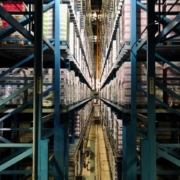The advantages of shortening lead times
Long lead times due to multiple ‘errors’ in your processes not only waste capital utilization, but also the efficiency and quality of your production is put under pressure.
Freeing up capital
Imagine: a factory makes 15 products per working day. And each product contains € 300 in material. The lead time is 2 weeks (10 working days). All material is needed from production day 1. So there is always material for 10 (production days) x 15 (products per day) in the factory. That is a value of 10 x 15 x € 300 = € 45,000 in (intermediate) stocks and work in progress.
And imagine: we can shorten the lead time to 1 working week. Then there is only 5 (working days) x 15 (products per working day) x € 300 = € 22,500 in material and work in progress. That means € 22,500 in released capital. And we still make 15 products a day. The organization has therefore released € 22,500 capital as a result of shortening the lead time for other objectives.
Other benefits
In the first situation, the production manager has to manage the process of 150 products at the same time. So 150 chances of disruptions, bottlenecks and mistakes. In the second case, he only has to keep an eye on 75.
The amount of stock also decreases in the factory. This not only reduces the capital requirement but also reduces the amount of space, risk and interest burden on the capital. Free space in particular can then be used more efficiently.
Urgent
The common problem is called ‘Emergency’. At the last moment due to the customer or internal problems, an order suddenly has priority. The planning can be overhauled, machines have to be changed so that a domino effect is created in the organization of instability in the goods flow. This takes a lot of time for each organization in terms of coordination and position. So many unnecessary costs.
Leverage effect
Goldratt has shown that movements in the stock have a leverage effect. Organizations often take action to reduce their WIP. But this has only a limited effect. Wastes such as waiting times, internal transport and storage have a greater impact on lead times.
Companies often look for a reduction in their lead time in order to ultimately reduce costs. The problem of thinking only in terms of costs provides a sub-optimal effect when it comes to shortening lead time. The focus should be on removing bottlenecks and identifying the new bottleneck again and again. [Goldratt] By placing the focus here, the WIP will automatically decrease and the time that WIP is in production will also be lower. This provides a significant improvement in the operating result.
The secondary effect of focusing on turnaround time improvement by resolving bottlenecks is that this means an inherent improvement in quality in terms of product, processes and human performance. Step by step your organization grows towards a pull strategy where possible. [Lean]
Reduce the batch size
The batch size is not optimally defined in many organizations, but maximally, with a lot of attention being paid to the changeover periods. Converting machines takes a lot of time. With a view to (again) the costs of these conversion procedures, a maximum batch size is often chosen, so that conversion costs can be minimized.
By maintaining a maximum batch size, waiting times are created within the production process. During the production of “Order X”, “Order Y” is on hold, because adjustment is necessary. The batch size is therefore one of the core causes of waiting times within production processes. The reasoning that a smaller batch size results in an increase in product costs is absolutely incorrect.
After all, the maximum output of a production process is always determined by the bottleneck process. The changeover of the bottleneck process is the only changeover within a production process that can result in a reduction of the output. Other changes of sub-processes have no effect on the output, because the bottleneck process is leading and thus determines the maximum output of the production process.
Changeover times always lead to machine standstill. Regardless of the duration of this standstill, it can be concluded that the conversion of machines has a relative influence on the lead time reduction. Reducing the turnaround time makes it necessary to reduce the changeover times of the bottleneck process (SMED). A reduction in the changeover times of other sub-processes will only become profitable as soon as they risk becoming a bottleneck.
Bottleneck process
The above illustrates how additional waiting time for work orders is created. Release of work orders on, for example, process A can lead to storage (= stock) for the bottleneck process C. The pace of the entire production line is thus determined by process C. However, due to the traditional approach to efficiency, the “temptation” within many organizations is great to release the work order for process A, with all its consequences.









